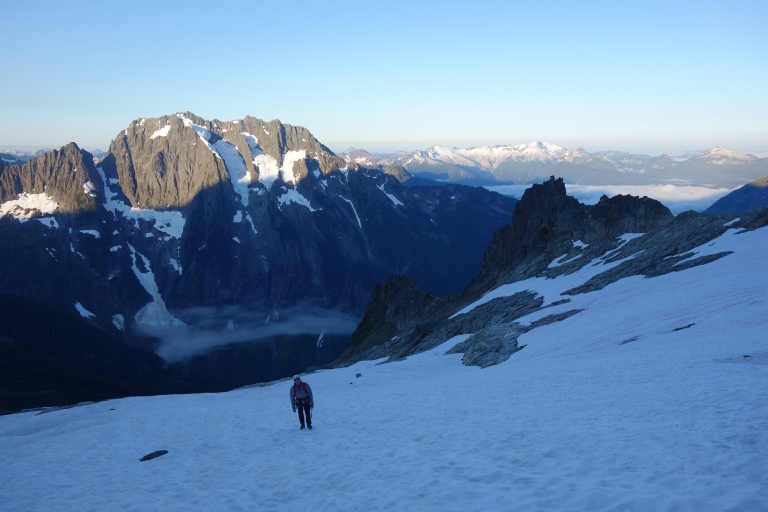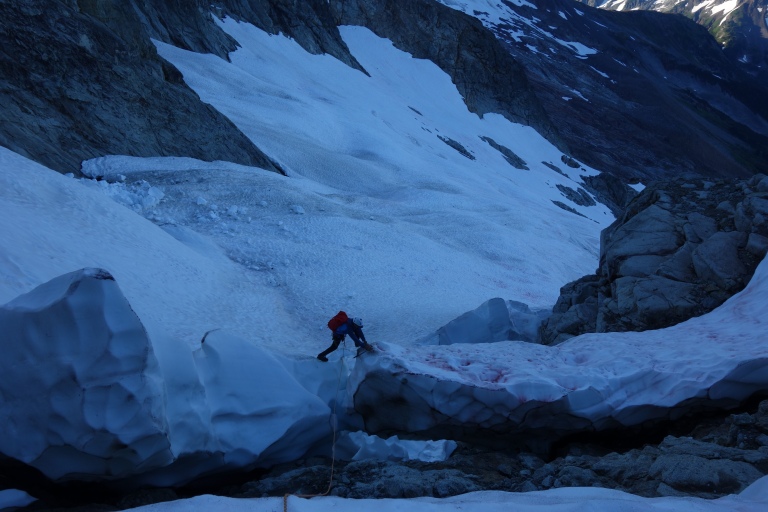John and I climbed the ultra-classic West Ridge of Forbidden Peak in a day on August 4th, 2018. This is one of the 50 Classic Climbs of North America.


John and I tried to climb Forbidden Peak last year with a camp in Boston Basin, but weather forced us to bail. This time, we committed to climbing the peak in a single push – this was a great choice. Going car to car means that you can hike and climb with a very light pack, which makes everything easier and more enjoyable. Perhaps most importantly, going car to car allows you to avoid the annoying chore that is obtaining overnight permits for Boston Basin. We made good time on the approach and were passing the lower bivy after less than two hours of hiking. Without much drama, we’d navigated the glacier-polished slabs below Forbidden Peak and geared up. The snow conditions were fantastic and we made great time. I made an interesting routefinding choice at the big rock outcrop below the West Ridge Couloir – I went right, instead of left. We did some spicy steep snow and snowbridge crossing that required a couple of belays.

We were stoked to be the first team on route for the day. The West Ridge couloir was out for the season, so we knew that we would need to climb one of the “Cat Scratch” gullies to the left of the couloir. This is probably the most dangerous part of the climb – all of the gullies are full of loose rock, so party-induced rockfall is a major concern here. With no teams ahead of us, rockfall hazard was somewhat mitigated. I set off on the first of many simulclimbing blocks. The loose 4th class climbing of the gully went quickly and we arrived at the West Ridge Notch, where we ditched our ice axes and crampons. Time to rock climb!



The route on the ridge was phenomenal – this is as classic as it gets. Moderate, exposed ridge climbing with minimal routefinding brought us higher and higher on the ridge. The 5.6 crux was well protected with an old piton and a nut placement. John and I only brought approach shoes, which were perfect for this easy climbing. The combination of fun, easy climbing and incredible views reminded me of Pigeon Spire’s West Ridge.



We arrived at the true summit of Forbidden almost exactly 7 hours after leaving the car. John and I couldn’t believe how smoothly the day was going. We lounged in the perfect weather, feeling no rush to descend.




Finally, we made our descent. With no other parties high on the route, the descent was painless and fun. We made several rappels interspersed with 4th class ridge climbing until we regained the notch and our cache of equipment. From here, 6 rappels brought us all the way to the glacier remnants, where we could unrope. Once we reached the rock, I stopped to take a sample of snow algae for The Kodner Lab.


On our hike down, we came across a man who had been critically injured in a fall from the approach slabs below Forbidden Peak. Together with some other climbers, we rendered first aid as best as possible given our position and limited resources. I used my InReach device to summon a rescue and communicate with emergency services – this was invaluable. Unfortunately, our rescue efforts were not successful. The hike to the car was long and soaking wet, with a mix of rain, hail and lightning the entire way down. It was a bad way to end a day of incredible climbing.
Strategy Notes
Skip the bivy and go car to car for most climbs in Boston Basin. The approach is easy with a light pack, and soul-crushing with a heavy one. My pack weighed 16 pounds.
Gear Notes
60m rope (we used a 60m twin folded in half – perfect system for this route!), single rack .3-2, nuts, 6 alpine draws and four double length slings. Neither of us brought boots or climbing shoes, opting to do everything in approach shoes. Aluminum crampons worked well for the short snow section and my superlight CAMP Corsa Nanotch axe was great, as always. I was really happy with our gear choices. You never really need to carry more than a liter of water in Boston Basin because water is so easily available from the multitude of streams and snowfields. Make sure that you have some form of communications device in case of emergency – I believe that an Inreach is the best option given its capabilities.

3 thoughts on “Forbidden Peak – West Ridge (III 5.6)”